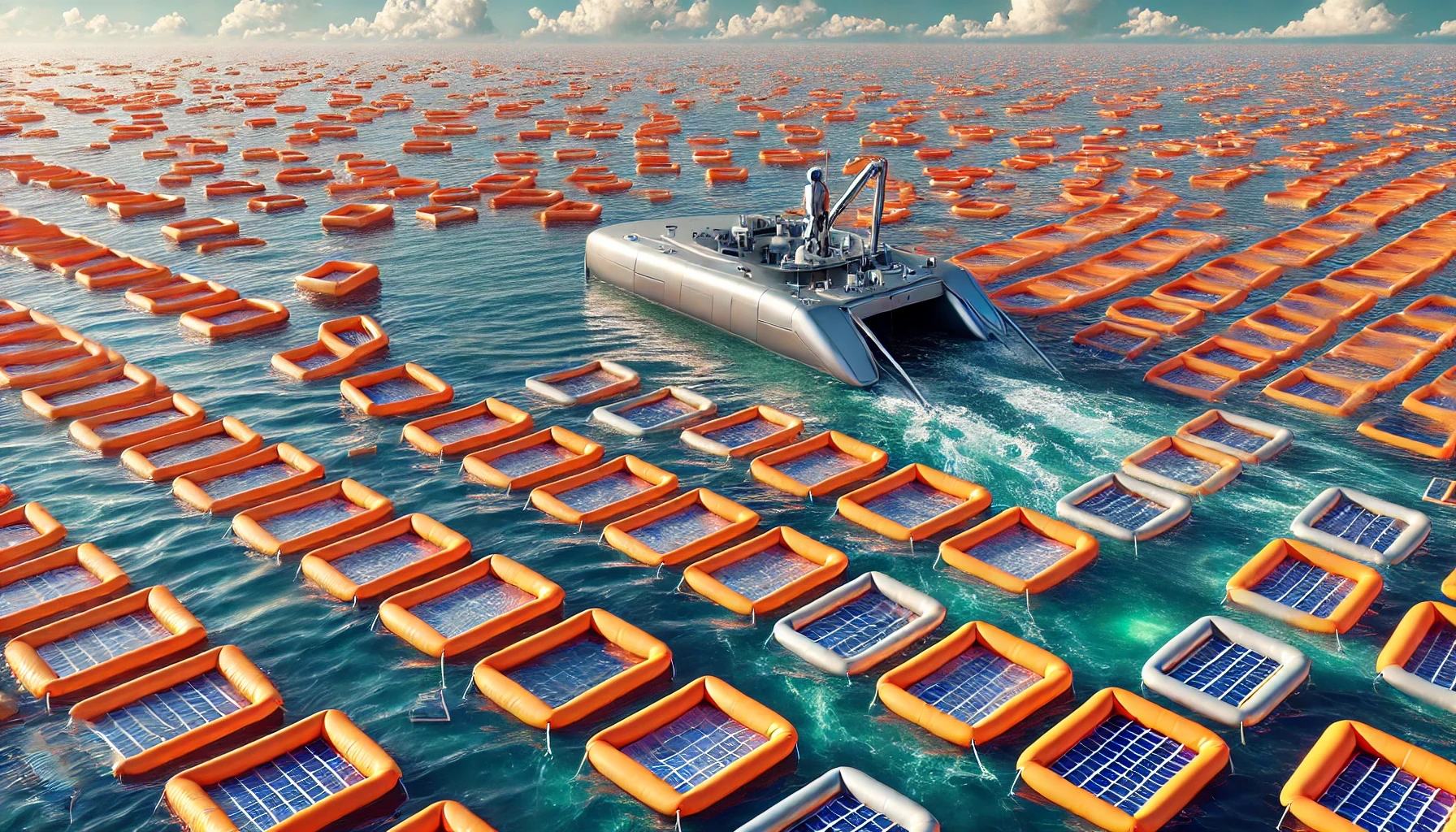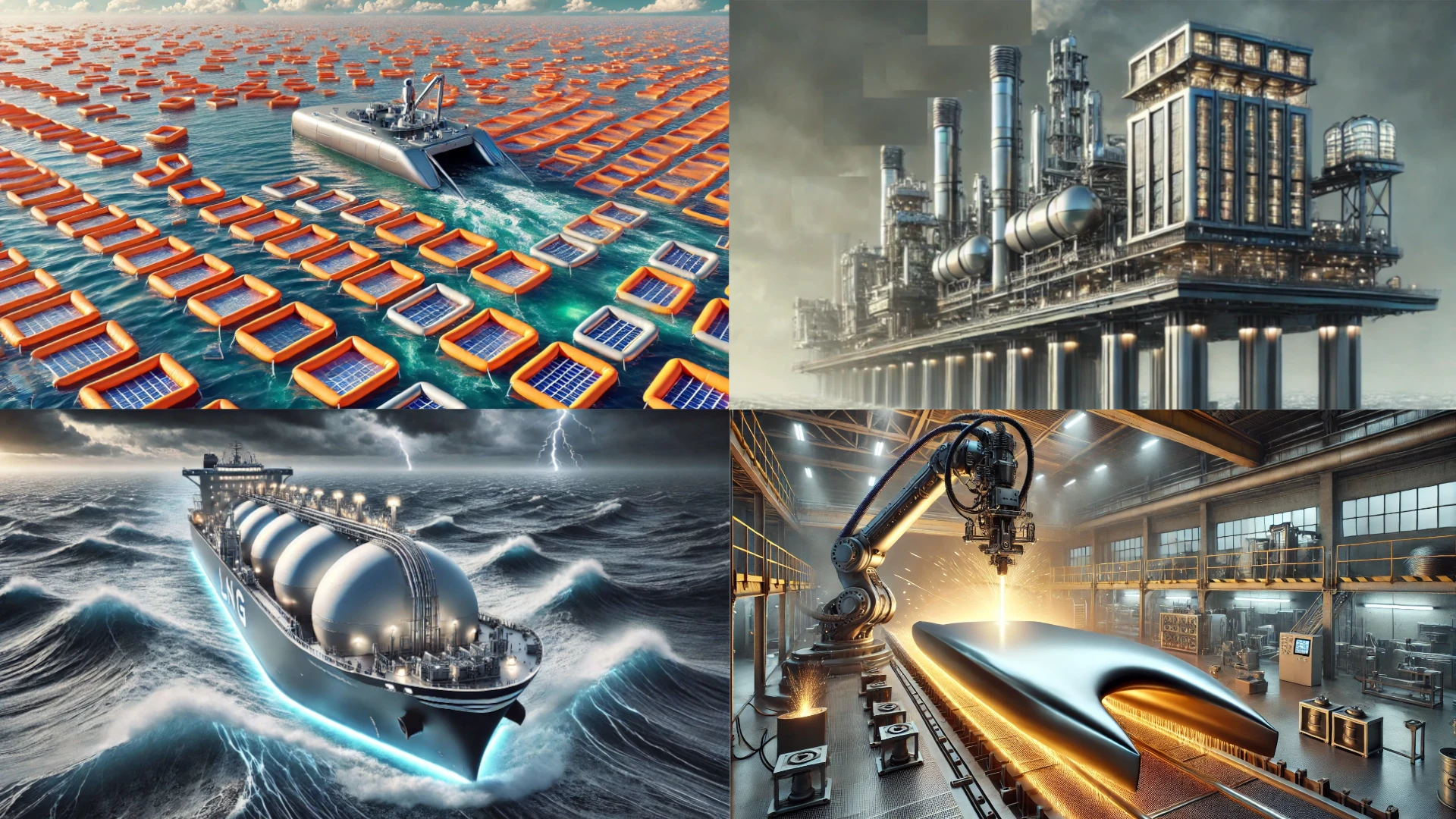Floating Solar Empires: Could This Audacious Project Solve the Climate Crisis and Fund a Global Basic Income?
The Tabbre Project aims to harness the sun's power on an unprecedented scale, using blockchain technology to create a new energy economy and a more equitable world.

An artist impression of a harvester in a floating solar farm
We're living in a world powered by contradictions. We need more energy than ever, yet our reliance on fossil fuels is driving us towards climate catastrophe. Billions lack access to reliable, affordable power, while renewable solutions struggle with intermittency and high costs. It's the energy paradox, and it's one of the defining challenges of our time.
But what if there was a way to break this deadlock? What if we could harness the boundless energy of the sun, not in scattered patches, but on a truly global scale? What if we could create a system that was not only clean and sustainable but also cheaper and more equitable than anything that exists today?
Enter the Tabbre Project.
The Vision: Deserts of the Sea, Oceans of Power
The Tabbre Project, spearheaded by Charles Cunningham, proposes a radical solution: vast, autonomous floating solar farms located in the oceanic gyres. These aren't your typical solar panels; they're a revolutionary reimagining of renewable energy production.
Why the gyres? These vast, swirling regions in the middle of the world's oceans are, in many ways, the perfect location:
Biological "Deserts": Far from land and major shipping lanes, the gyres are characterized by extremely low biological productivity. This minimizes the environmental impact of deploying large-scale infrastructure.
Abundant Sunlight: Located in tropical and subtropical latitudes, the gyres receive consistent, intense sunlight year-round.
Calm Waters: Gyres are known for their relatively calm seas and low wind speeds, providing a stable environment for floating structures.
Vast, Unused Space: The gyres offer millions of square kilometres of open ocean – ample room for scaling up energy production to meet global demand.
Still water. There are next to no currents in the gyres.

A world map highlighting the major oceanic gyres in the southern hemisphere
The Technology: Floating Rafts and Robotic Harvesters
The core of the Tabbre system is the floating solar raft. Imagine a large, circular, inflatable structure, almost like a giant, high-tech lily pad. Its surface is covered with thin-film perovskite solar cells – a cheaper, more flexible, and potentially more efficient alternative to traditional silicon panels.
But these rafts don't just generate electricity; they produce hydrogen. Each raft has an integrated electrolyzer unit that uses the electricity to split desalinated seawater into hydrogen and oxygen. The oxygen is released, and the hydrogen is stored within the raft's inflatable structure, providing both buoyancy and a built-in storage solution.
A close-up diagram of a Tabbre solar raft, showing its key components
The hydrogen is then collected by autonomous harvester vessels – think robotic ships designed for the open ocean. These vessels, based on the stable SWATH (Small Waterplane Area Twin Hull) design, navigate the gyres, retrieve the rafts, extract the hydrogen, replenish the rafts' water supply, and perform any necessary maintenance.

Diagram showing the harvester SWATH (Small Waterplane Area Twin Hull) concept
Top down view of harvester vessels ministering to solar rafts
The harvested hydrogen is then transported to floating factory platforms, where it's converted into either ammonia (a key ingredient in fertilizers and a potential fuel for ships) or methane (synthetic natural gas), using well-established chemical processes powered by renewable energy. These fuels can then be shipped to markets worldwide, providing a clean alternative to fossil fuels.
The Tokenomics: TABB and BRE – Powering a New Economy

The Tabbre Project isn't just about technological innovation; it's about building a new, decentralized energy economy. This is where its two cryptocurrencies, TABB and BRE, come in:
TABB (Token for Administering the BRE Blockchain): The governance and investment token. Holding TABB gives you a say in the project's direction (through a Decentralized Autonomous Organization, or DAO) and a share in its potential profits. A "buyback and burn" mechanism is designed to increase TABB's value over time.
BRE (Basic Renewable Energy): The utility token, a stablecoin pegged to the price of energy produced by Tabbre. This is the currency you'll use to buy Tabbre's energy, and it's also the currency that will be used to distribute a Global Universal Basic Income (GUBI) – a regular, unconditional payment to individuals worldwide.
Schematic showing the Tabbre scheme and the role of BRE and TABB
The Impact: Beyond Clean Energy
The Tabbre Project's potential impact extends far beyond simply providing clean energy:
Climate Change Mitigation: By displacing fossil fuels on a massive scale, Tabbre could significantly reduce global greenhouse gas emissions.
Energy Abundance: Providing affordable, reliable energy to everyone could unlock economic growth and improve living standards worldwide.
Poverty Reduction: The GUBI, funded by Tabbre's profits, could lift millions out of poverty and provide a basic level of financial security.
Financial Inclusion: The decentralized nature of the Tabbre ecosystem could provide access to financial services for the billions who are currently unbanked or underbanked.
A New Global Currency: The project will establish a new global currency, free from the control of central banks, and available to everyone.
The Challenges: Navigating the Uncharted Waters

The Tabbre Project is undeniably ambitious, and it faces significant challenges:
Technological: Scaling up perovskite PV production, developing robust autonomous systems, and optimizing the chemical processes will require constant innovation.
Financial: Raising the necessary capital (trillions of dollars over the long term) is a massive undertaking.
Logistical: Managing a vast, distributed network of floating infrastructure in the open ocean is a complex task.
Regulatory: Navigating international maritime law and securing the necessary permits and approvals will be crucial.
Geopolitical: navigating the current era of heightened Geopolitics.
The Call to Action: Join the Revolution
The Tabbre Project is more than just a project; it's a movement. It's an invitation to be part of a future powered by clean energy, where financial systems are more equitable, and where everyone has the opportunity to thrive.
Want to learn more? Visit the Tabbre Project website [Insert Website URL Here], join the community forum [Insert Forum URL Here], and follow the project on social media [Insert Social Media Links Here]. Consider investing in TABB, becoming a validator on the TabbreChain, or simply spreading the word.
The future of energy is being built now. Will you be a part of it?
See our website: tabbre.com
Donate via our GoFundMe
Author bio:

I'm Charles Cunningham the founder and CEO of the Tabbre Project. I founded the Tabbre Project because Net Zero policies are making access to energy unreliable and expensive. This is a disaster for the world's poor. My career of over 40 years working in Europe, North America and the UK that included senior business, engineering and IT roles in industries such as blockchain, banking, energy, automotive manufacturing, utilities and central government, has equipped me with the skills and knowledge needed to deliver the Tabbre Project.
#RenewableEnergy, #Blockchain, #Cryptocurrency, #ClimateChange, #UBI, #DeFi, #Sustainability, #TabbreProject, #TABB, #BRE


